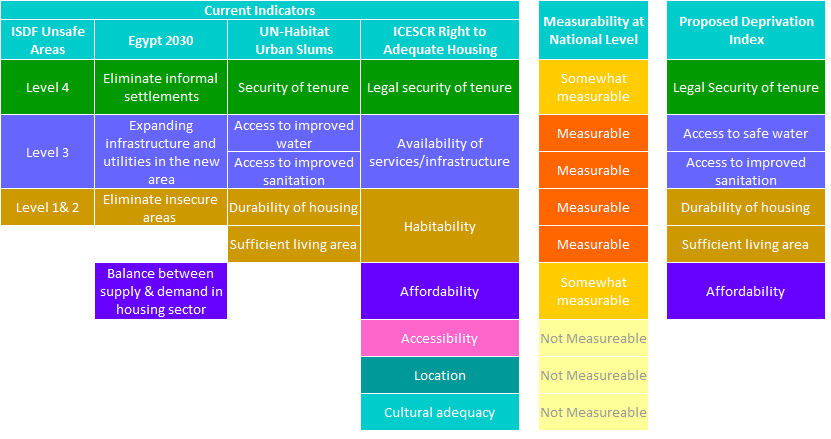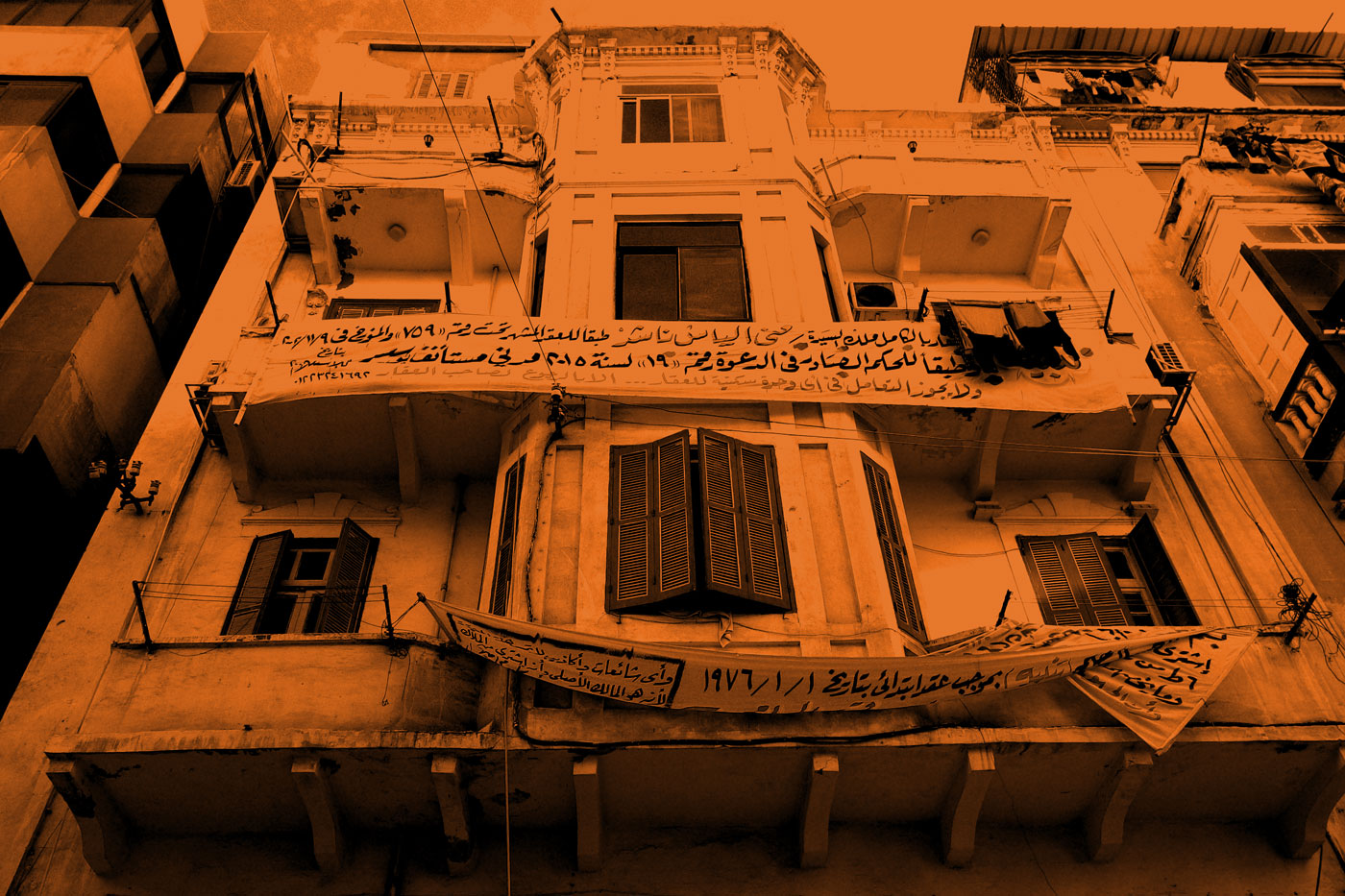Overall Indicator of Deprivation in the Built Environment

Summary
Table of Contents
One third of Egyptian households (34.1%) live in a deprived built environment. These households are deprived from one or more of six quantifiable components that have been used to define adequate housing; affordability, durable housing, secure tenure, sufficient living space (crowding), safe water and improved sanitation.
For more on each indicator please click on the icons at the top of the page.
How is deprivation a problem?
Households that live in a deprived built environment, whether a city, town or village, in a formal or an informal area, are subjected to many hardships. Some are exposed directly to dangers such as the loss of one’s home to collapse, flash floods or forced eviction. Others have to endure health and social problems due to crowded living conditions, unclean water or exposure to raw sewage. Housing costs, whether to buy or rent, already burden a majority of Egyptian households, a considerable portion of which already live in deprived areas.
Who live in the more deprived areas in Egypt?
The largely rural region of Upper Egypt is the most deprived, where the percentage of households living in a deprived built environment ranged between a slightly above average 37.4% in Luxor, to 51.3% in neighbouring Qena, the most deprived governorate in Egypt.
The rural-industrial Delta was the region with the second highest deprivation, where it ranged between a slightly below average 29.4% in Munufia, to an above average 43.5% in Gharbia.
Deprivation in Greater Cairo was just under the national average, where between 23.7% and 33.6% of households were deprived. Households in the Suez Canal region experienced below average deprivation that ranged between 22.2% and 27.9%.
The Frontier desert governorates surprisingly had the lowest incidences of deprivation, which ranged between 5% in the New Valley (the least deprived governorate), and 19.5% in the Red Sea.
Why is there deprivation in the built environment?
Urban and housing policy have been largely misguided over the last few decades. The majority of public spending on infrastructure has been devoted to so-called New Cities in a failed effort to divert urban expansion away from agricultural land to new communities in the desert. While subsidised housing programmes have mostly comprised of singular solutions based on ready built social housing, which has been inappropriate for a majority of households as well as expensive for the poor. Affordability in general has been eroded due to a deregulated property market and the commodification of formal, serviced land in the New Cities and elsewhere.
And while there has been some official effort to address deprived communities, the lack of a clear set of deprivation indicators amidst myriad official definitions of communities in Egypt such as urban or rural, formal or informal, planned or unplanned, and safe or unsafe areas, has led to an inefficiency of development. More importantly, the arbitrary term of ‘ashwaeyat, literally randomly [built communities] which has been used by officials to describe any community that displays a wide range of deprivation from urban decay, to lack of services, to lack of title, has also been used in the articles of the 2014 constitution to define deprived areas. These constitutional articles are therefore at risk of becoming ineffective.
What can be done?
- Adoption of a legal definition for a deprived community and/or adequate housing outlining a specific set of deprivations
- Form built environment policy on urban and housing issues to address deprivation in the built environment as defined in the legal definitions.The Egypt 2030 Sustainable Development Strategy has a number of indicators in its Urban Development Pillar that can be expanded to include the proposed indicators.
- Measure deprivation on a periodic basis to assess implementation of policy
Methodology
Definition of deprivation in the built environment
The 2014 Egyptian Constitution includes a number of terms used to describe deprivation in the built environment;
- Al-Maskan al-Mulaem, Adequate Housing; Article 78 states that citizens have a right to adequate housing.
- Al-‘Ashwaeyat, Slums; Article 78 also states the re-planning of slums, and making available infrastructure and raising the quality of life.
- Al-rif, Development of Rural Areas; Article 29 defines the development of rural areas.
- Al-matiq al-hududeyya, wal-Mahruma, frontier and deprived Areas; Article 236 states the development of frontier and deprived areas.
However the terms used have as yet no legal definition. Though since Egypt is party to the International Covenant on Economic, Social and Cultural Rights, we have used its comprehensive definition on adequate housing as a baseline to deifine on deprivation in the built environment.
General Comment 4/1991 defines adequate housing as providing housing that;[1] has legally secure tenure, has access to services, materials, facilities and infrastructure (water, sanitation and electricity), is affordable, habitable (sufficient living space and durability), is accessible (to disadvantaged groups), is well located (to employment and social services), and is culturally adequate.
Quantitative Measurement of Deprivation
There have been a number of both national and international methods to measure deprivation in the built environment, though none have been comprehensive enough in their reach, where they either focused on urban populations, excluding rural ones, or focused on informal self-built communities, excluding deprived households in formal public and private sector built communities
- National Map of Unsafe Areas: The Informal Settlements Development Facility (ISDF) has used its own set of indicators to identify ‘unsafe’ areas, identifying 404 such areas in 2009, home to about 208,000 families. The indicator is a restructured UN-Habitat slum indicator, rearranging the five indicators into four levels of danger,[2] though the number of families identified severely under-represents the number of families living in deprived communities as it only includes those thought to be at imminent physical danger from those deprivations. For example Level 3 unsafe areas identify 50,582 homes as having conditions that constitute a health risk, which include unsafe water and inadequate sanitation. In contrast the CAPMAS census of 2006 puts those figures as 2.3 million and 9.2 million households respectively. While those living in dangerous conditions have also been under-represented where Level 1 and 2 areas included 13,431 and 121,284 homes respectively. However the Ministry of Housing’s Organisation of Technical Oversight on Buildings (OTOB) counts 514,616 units in need of demolition or repair,[3] or five times the ISDF number.
- UN-Habitat Slums indicator/ MDGs/ SDGs: Used to monitor countries’ progress towards the UN Millennium Development Goals (MDGs), as well as the current UN Sustainable Development Goals.[4] For the MDGs, this indicator has shown that the number of people living in urban slums in Egypt has dropped from 12 million in 1990, to 4.5 million in 2009.[5] While comprehensive in the areas of deprivation it measures,[6] the UN-Habitat slum indicator has only been applied on less than half of the population, those who live in urban areas, excluding the majority who live in areas designated as rural. Also, disaggregated background data used to develop the indicator shows that only a handful of Egypt’s 27 governorates were represented in the indicators.[7]
- Sustainable Development Strategy: Egypt Vision 2030: This enacted strategy comprises a number of pillars with quantifiable targets to be achieved by the year 2030. The Urban Development Pillar includes five quantifiable indicators related to adequate housing; Balance demand and supply of housing, Reduce number of people living in unsafe areas by 100%, Reduce surface area of ‘ashwaeyat (unplanned areas) from 38% to 5%, Increase number of households with access to safe sanitation from 50% to 100%, Increase number of households with access to safe water from 90% to 100%. It is the most comprehensive indicator used to measure deprivation in the built environment in Egypt so far, however indicators on unsafe areas and unplanned areas are limited as explained above, while the indicator used to measure affordability does not adequately define access to affordable housing.
Methodology for calculating deprivation in Egypt
The Built Environment Deprivation Indicator (BEDI) has isolated six quantifiable indicators; affordability, tenure security, durability, crowding, safe water and improved sanitation, to measure deprivation in Egypt based on both the local and international definitions mentioned above (Table 1).
All six indicators measure deprived households as a percentage of total households in each of Egypt’s 27 governorates, culminating in a national average for each indicator. The main deprivation indicator for each governorate, as well as on the national level, is comprised of the average of the six indicators. All six indicators were given the same weight in order to provide a simple indicator of deprivation.
Table 1: Comparison of existing and proposed indicators to measure deprivation in the built environment in Egypt
 The BEDI relied mostly on publicly available data to generate the indicator. Most of the data was publicly accessible for free or for a fee, while other data required special data requests to official agencies. House and rent prices were the only data gathered exclusively for the research.
The BEDI relied mostly on publicly available data to generate the indicator. Most of the data was publicly accessible for free or for a fee, while other data required special data requests to official agencies. House and rent prices were the only data gathered exclusively for the research.
Limitations
Three of the six indicators (crowding, water and sanitation), relied on the Central Agency for Public Mobilization and Statistics (CAPMAS) 2006 census data, which while comprehensive, may be outdated as the next census of 2016 is still underway.
Two indicators relied on official statistics (durability and insecure tenure), which are not comprehensive due to the nature of the data gathering, or use multiple estimations to fill in gaps in the data. Thus we consider them to under-represent the deprivation they aim to measure.
The affordability indicator relied on house and rent prices gathered exclusively for the research, as well as forecasting current income from previous CAPMAS Household Income, Expenditure and Consumption Surveys (HIECS).
To ensure continuity between the data sets, percentages of deprived households, rather than numbers, were used.
Footnotes
[1] International Covenant on Economic, Social and Cultural Rights , Article 11-1, General Comment 4/1991 http://tbinternet.ohchr.org/_layouts/treatybodyexternal/Download.aspx?symbolno=INT/CESCR/GEC/4759&Lang=en [2] Level 1, Life-threatening Areas: Housing in areas prone to rock-slides, flash floods or adjacent to railway lines, Level 2, Inadequate Housing: Shacks and decayed historic urban cores, Level 3, Health-threatening areas: Housing deprived of water or sanitation, or built under high voltage lines or affected by industrial pollution, Level 4, Unstable Areas: Housing built on public land (insecure tenure) [3] "Al-Taftish 'ala al-bina': 60 alf 'aqar ayil lil-suqut wal-Qahira tahtal al-martaba al-ula", Masrawy, 08.03.2014. http://goo.gl/NcSNcd [4] Goal 11: Make cities and human settlements inclusive, safe, resilient and sustainable https://sustainabledevelopment.un.org/sdg11 [5] UNStats – MDG Indicators, Goal 7; Ensure Environmental Sustainability, 7.10 Proportion of urban population living in slums http://mdgs.un.org/unsd/mdg/Metadata.aspx?IndicatorId=32 [6] According to UN-Habitat an urban slum household is a household that lacks any one of the following five elements: 1)Access to improved water, 2) Access to improved sanitation, 3) Security of tenure, 4) Durability of housing, 5) Sufficient living area http://ww2.unhabitat.org/mdg/ [7] See: http://www.devinfo.info/urbaninfo/

